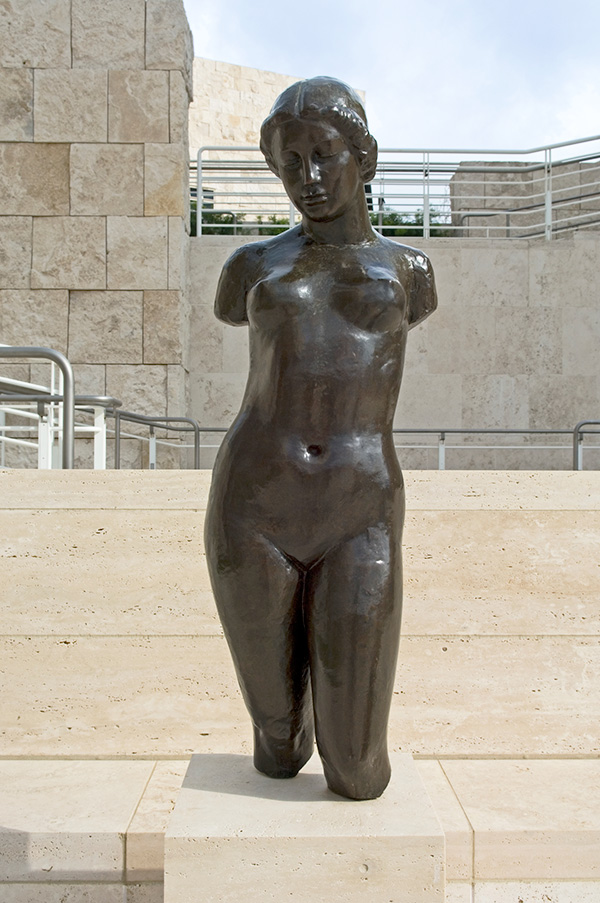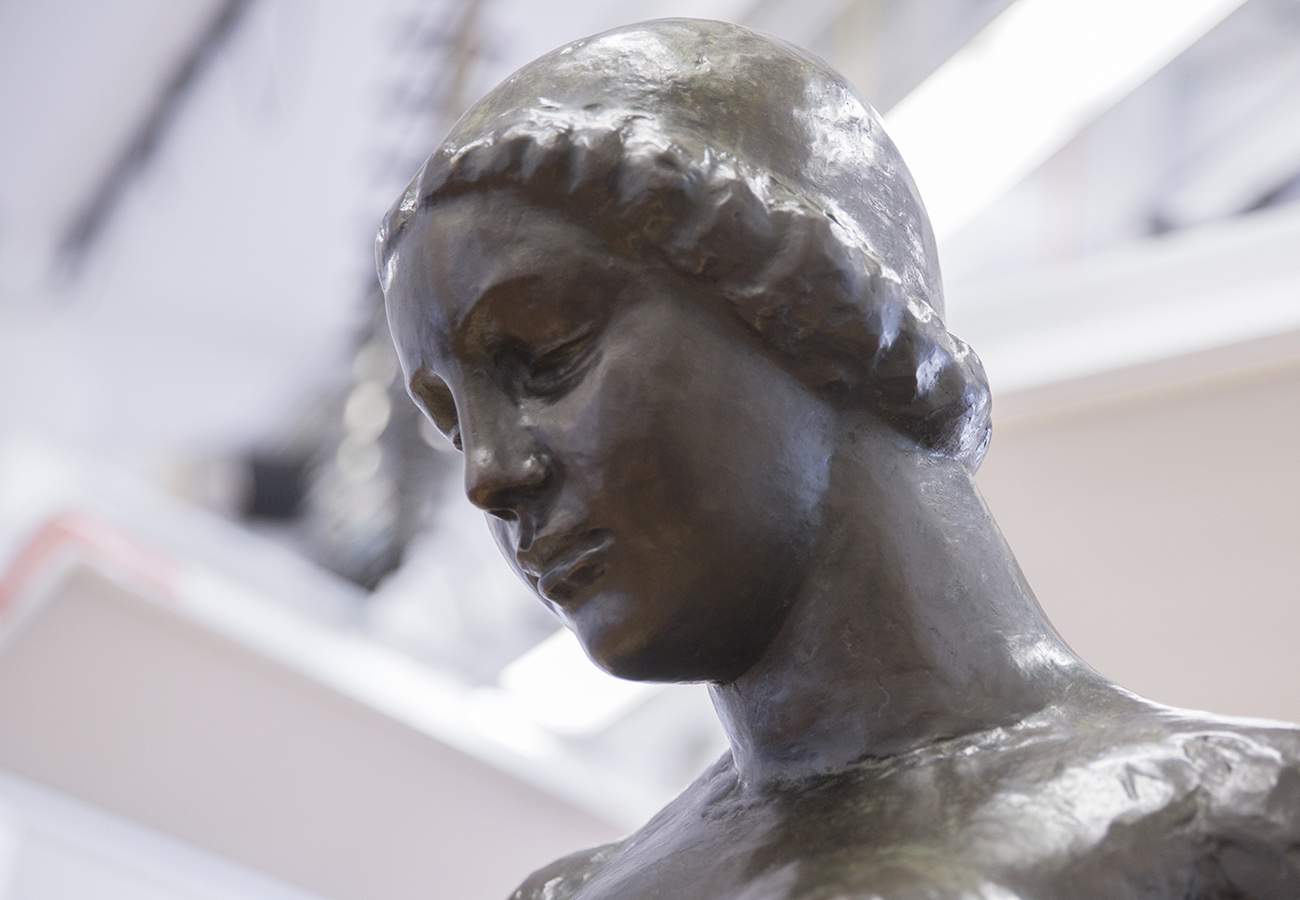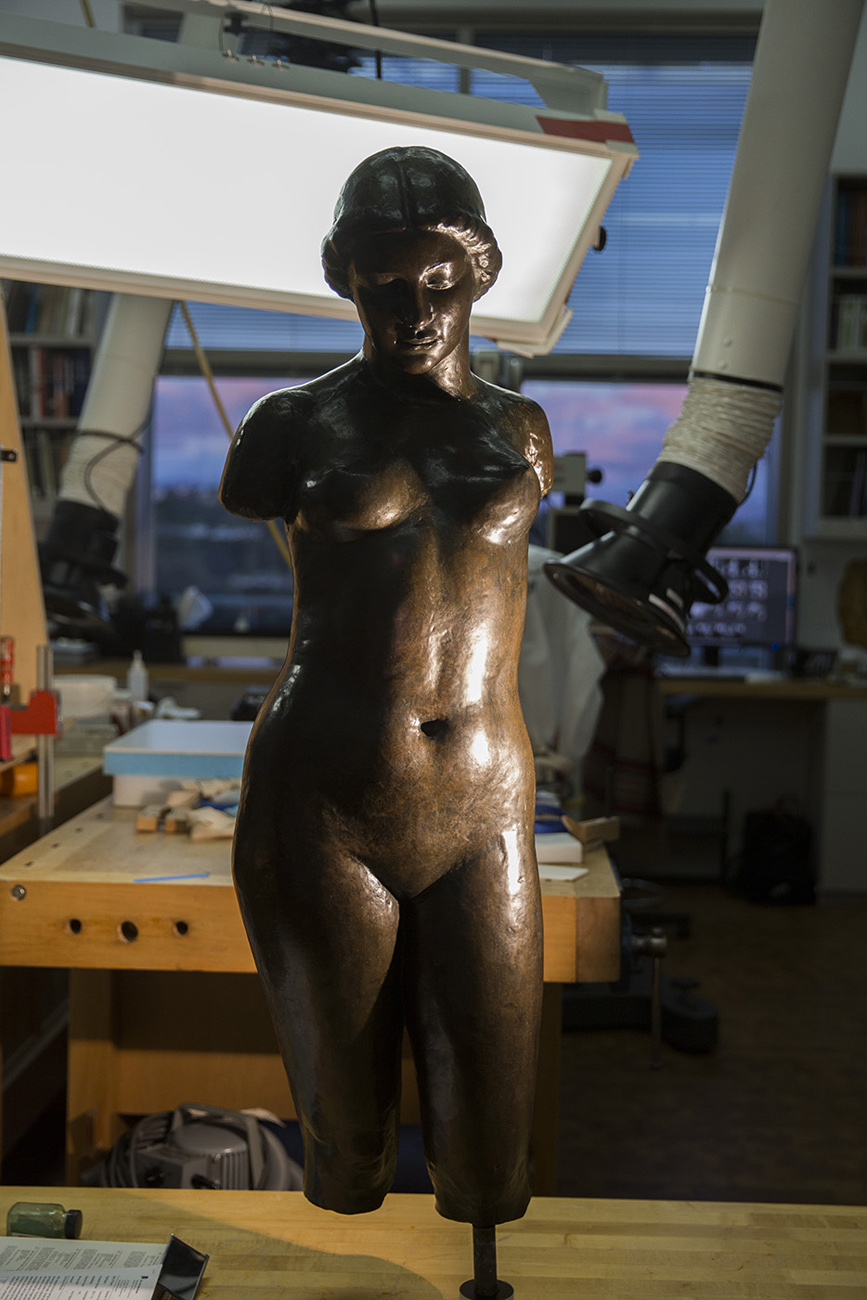On a recent Thursday afternoon, I walked over to one of the Getty Museum’s conservation studios to talk to grad intern Kellie Boss about her work conserving Aristide Maillol’s Torse de Dina (Torso of Dina), a sculpture that normally stands outside at the Stark Sculpture Terrace overlooking the Central Garden. Sculpture displayed outdoors takes a beating—the victim of weather, pollution, and the sun—and so it had been brought inside for scheduled maintenance.
Kellie is in residence at the Getty for the last year of her MA in art conservation at Buffalo State. She is one of the rare breed of people who gets to explore works of art, and the stories they tell, to a degree few people get to: she can touch the art.
Art conservators qualify for the privilege of touch because they study and train for years at the intersection of art and science. They give artwork individualized, preventive treatment based on careful consideration of a piece’s materials, the artist’s aesthetic choices, and where it’s displayed. They also consider a guiding ethic of today’s art conservation, which favors treatments that may be modified with better, future science.
Standing in the conservation studio, looking up at the gleaming and graceful contours of the newly cleaned bronze nude, Kellie told me what she’s learned from getting to know the Torse de Dina so intimately. It turns out that, even in the course of “routine” treatment of art objects, conservators have the opportunity to contribute to better, future science, helping to ensure an artwork’s stories may be long told.

The Torse de Dina as she looks when installed outdoors on the Stark Sculpture Terrace. The J. Paul Getty Museum, Los Angeles, Gift of Fran and Ray Stark
Inside the Process
First, Kellie reviewed the exhaustive written and photographic documentation on the current state of the artwork. But knowing the physical state of a work is not enough. Conservators also need to understand the art as art, which is one of Kellie’s favorite parts of her chosen career.
This was her first time treating a piece by Aristide Maillol. Art historians credit the French sculptor with breaking a new trail in Western sculpture, directing it away from the impassioned style and focus on the male form of the 19th century (see: Rodin). Blending Greek classicism with a modern perspective, Maillol championed a simplified, almost abstract style and helped to revive the female nude as a subject.
With Torse de Dina, we witness the output of his last years of life. He was introduced to Dina Vierny in 1934, and she became his chief model and collaborator until his death in 1944. (Later, after years as an art dealer and collector, Vierny founded the Musée Maillol in Paris.) The artist produced this sculpture of Dina between 1941 and 1944, and while he usually sculpted in plaster from sketches of his models, this piece he sculpted from life.

Close-up of the face of the Torse de Dina
Next for Kellie came a close look into the object’s materials. Conservators may apply coatings to bronze sculptures to protect the surface. Often a wax, the coating saturates the surface and acts as a physical barrier between the bronze and things like moisture, UV radiation and pollutants that can lead to the deterioration of the sculpture. This coating needs to be periodically removed and replaced.
The Torse de Dina had a “sacrificial wax coating,” which, as it starts to degrade, is typically removed through the use of solvents. This time around, though, Kellie and her fellow conservators decided to try dry ice blasting to remove the wax. It sounds destructive, but this treatment can be very gentle, less labor-intensive, and more environmentally friendly than the traditional method when performed correctly. Using a Cold Jet MicroClean machine, the team took turns spraying the sculpture with a pressurized air stream of dry ice and shared the satisfaction of literally blasting the wax off. (Technically, the process induces “thermal shock”—temperature changes that produce cracks—in the wax.)

Kellie directs a pressurized stream of dry ice at the Torse de Dina to remove its wax coating
While the dry ice cleaning removed almost all of the wax on the Torse de Dina, Kellie, whose specialty is outdoor sculpture, wasn’t convinced that the nude was, in fact, nude: “I’ve worked with a fair amount of bronze, and to my eye, this still looked coated after we removed this layer of wax.” Her opinion was based on more than a feeling: the sculpture’s conservation record indicated it had once been coated with Incralac, an acrylic-based coating, that may or may not have been completely removed in a previous treatment.
To address the question, the team looked at the sculpture’s surface under ultraviolet illumination, where some waxes and other coatings fluoresce different colors. In this case, the conservators saw evidence that traces of wax remained in some nooks and crannies.
Next, they took a microscopic sample of the remaining coating and looked at it under a polarized light microscope. They found the sample was “very brittle,” appeared to contain small particles from corrosion, and was insoluble in commonly used solvents. In need of more evidence, they took the sample to Herant Khanjian, a conservation scientist at the Getty Conservation Institute, who was able to determine that the remaining coating was actually a wax.
That discovery would make for a poor climax in a movie—the wax was actually wax!— but it’s an “aha!” moment in conservation work. This new evidence supports a current theory in conservation science: as Kellie put it, “early waxes may have ‘complexed’ with the patina, becoming less soluble.” In layperson’s terms, that means conservators have observed that the wax and the sculpture’s original patina—the stable oxidation of a sculpture’s surface intended by the artist—seem to be interacting to form something new, though what that something is they are still investigating. What they do know is that removal of the very thin wax layer on the Torse de Dina could potentially remove some of the original surface and patina—and that they don’t want to disturb.
What’s Next?

The Torse de Dina in the Sculpture and Decorative Arts conservation studio
The conservation team is currently debating what coating to apply to the newly renuded Torse de Dina. They’re weighing the pros and cons of wax v. Incralac to protect the sculpture from corrosion, to preserve the artist’s aesthetic intentions, and to manage the practical realities of maintenance.
Once they decide, Kellie will devote her attention to the major project of her residency at the Getty, a year-long technical study of Henry Moore’s Seated Woman, and the Torse de Dina will be restored to her place outside, where she may be admired by visitors to the Getty Center, as much—I hope—for the hard work that maintains her as for her beauty.





Comments on this post are now closed.